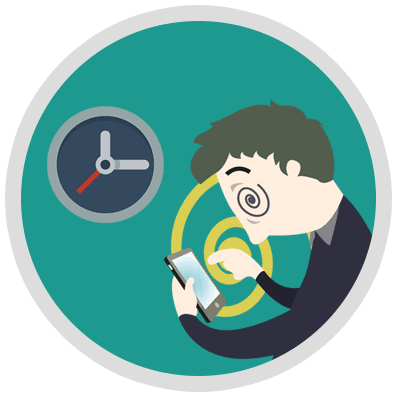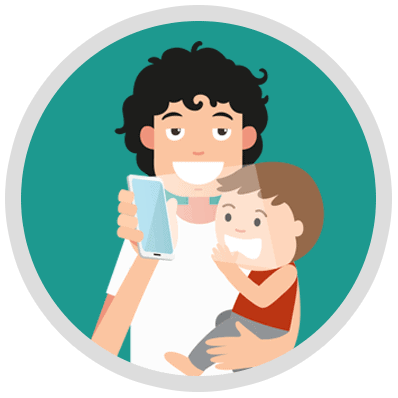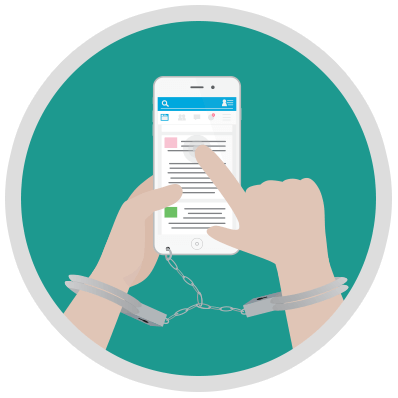Smartphone Addiction Facts & Phone Usage Statistics
The Definitive Guide (2020-2025 Update)

Smartphone manufacturers have been criticized for the addictive nature of their devices. Both Android and now Apple have released software that will help people curb their addition and monitor usage.
In this BankMyCell report we explore:
- Key smartphone addiction statistics
- Time spent per day using smartphones
- Children and phone addiction
- How smartphone usage impacts your health
- How to break up with your cell phone addiction
- Addiction solutions via an operating system
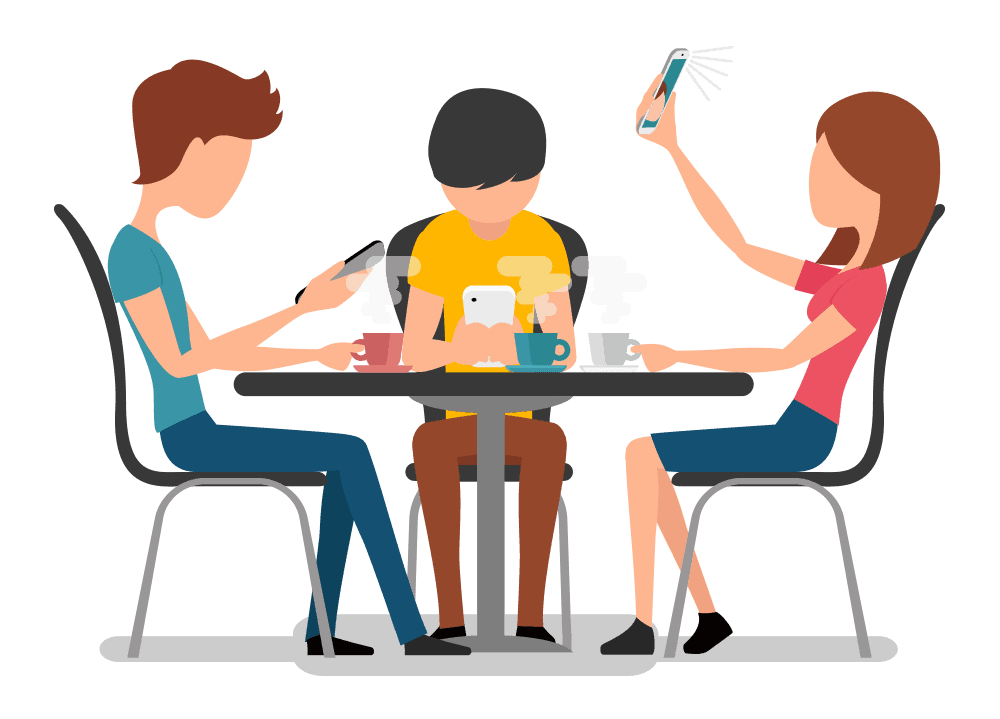
Guide Contents
Cell Phone Addiction Survey Data
Key Smartphone Addiction Facts & Symptoms
Smartphones have become a prominent part of everyday work and personal life. However, this huge culture shift in personal technology delivers an endless river of information that negatively impacts us psychologically – being linked to fueling anxiety, stress, concentration, sleep and much more.
In this section we explore:
- Smartphone infatuation statistics
- Defining smartphone addiction
- Insight into how it negatively impacts our lives
- Warning signs of smartphone addiction
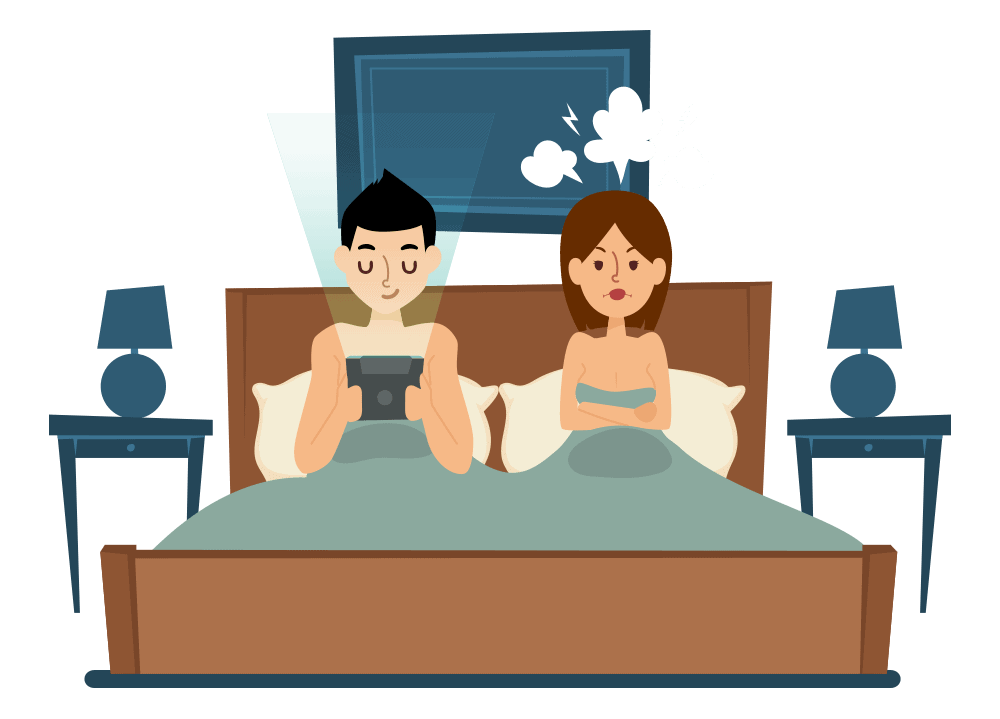
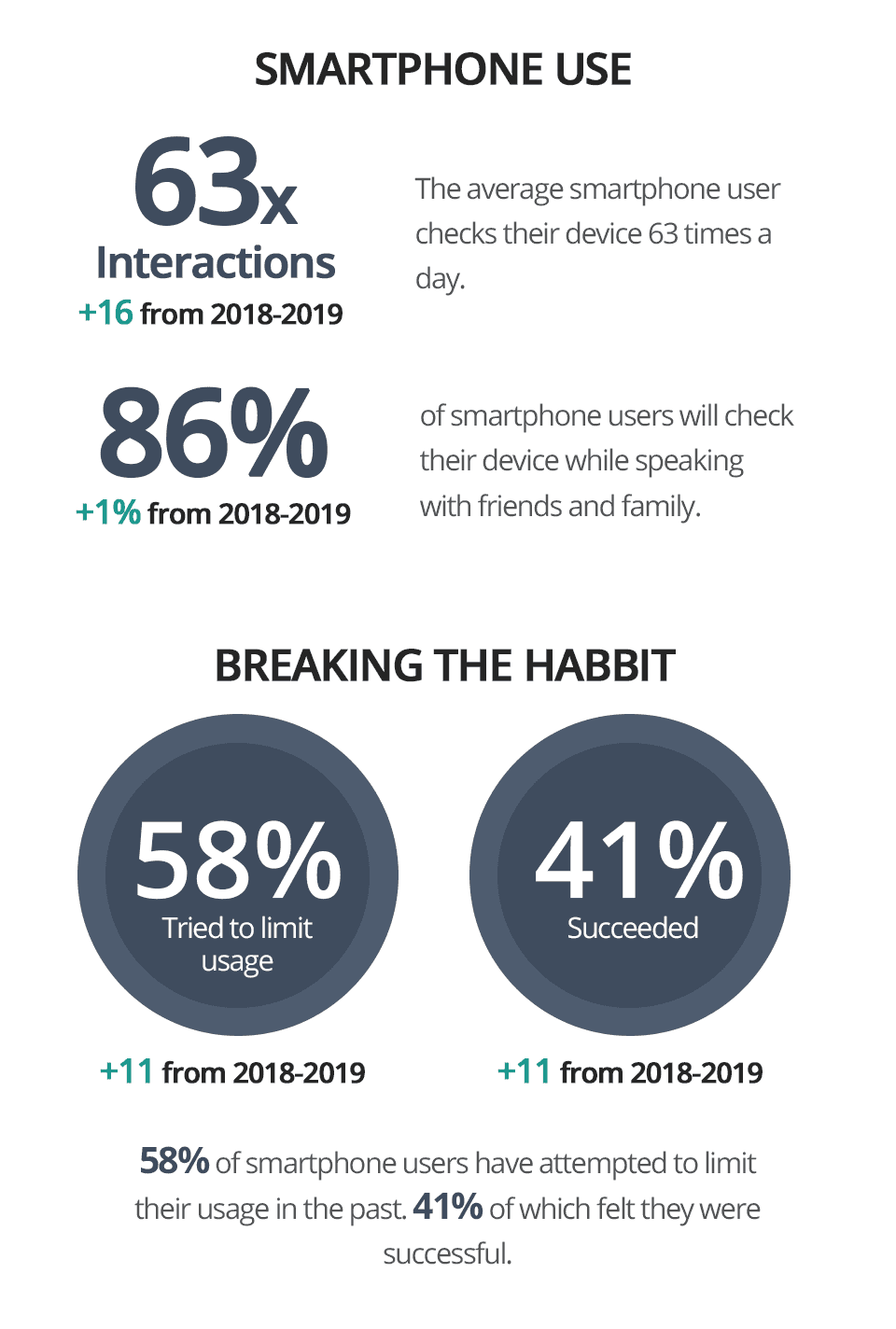
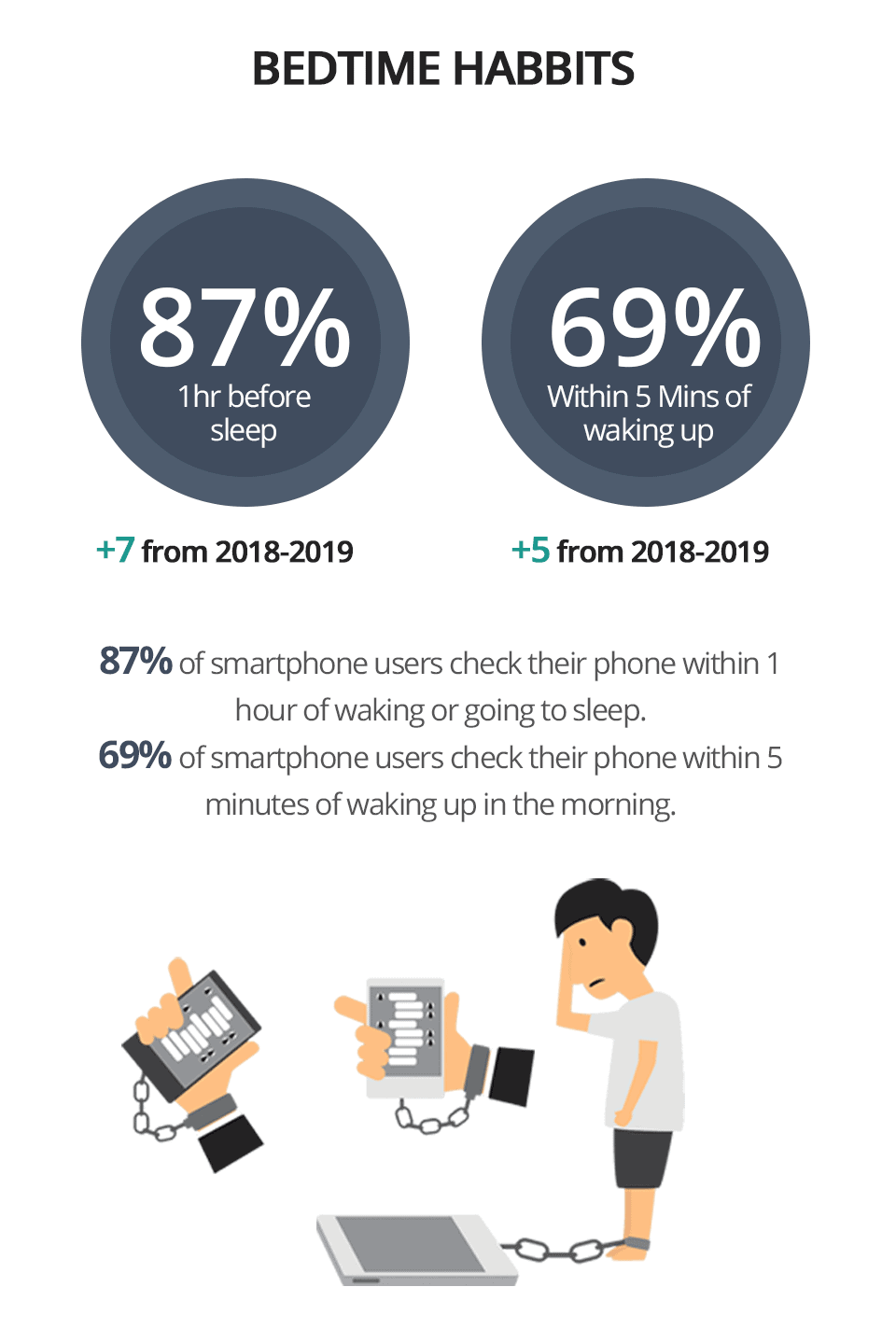
Is Cell Phone Addiction Real? Here Are The Facts
- The average smartphone user checks their device 47 times a day / 17,155 a year.
- Conversation killer! 85% of smartphone users will check their device while speaking with friends and family.
- 80% of smartphone users check their phone within 1 hour of waking or going to sleep, 35% of which will do within 5 minutes.
- 47% of smartphone users have attempted to limit their usage in the past – only 30% of which feel they were successful.
Smartphone Addiction Definition
The official name for smartphone addiction is Nomophobia which is defined as having a fear of not being with your phone. Cell phones have been around for years though, so why the sudden increase in personal dependence? Well quite simply, its defined by the nature of the content on the device… we’re talking internet, social networks, apps, video, music and so on.
Popular impulse driven triggers:
- Social media networks and relationship driven content.
- Overexposure to information and data e.g. games, surfing, apps.
- Internet pornography, cybersex and dating apps.
- Shopping, gambling, stock trading, and auctions.
How Phone Dependence Can Negatively Impact Our Life
All the research and studies we examined found that a phone usage dependence can impact both physical and mental health attributes of your daily life.
- Anxiety – Simply having your phone near you will decrease your productivity, the impact snowballs with the level of the users’ addiction.
- Stress – Higher stress levels were found in business orientated roles where work life is connected to the personas device e.g. emails
- Narcissism – People on their phones who get addicted to social media will begin to display self-absorption traits derived from posting constantly about their life or selfies.
- Depression and loneliness – mainly stemming from people on their phones with high social media use (higher numbers in teens).
- Attention deficit disorder – The flow of information can impact the brains’ ability to stay focused on one task for more than a couple of minutes
- Sleep deprivation – Impacting your sleep can have long-term mental health, memory and learning skills.
By the time you finish reading this you might want to sell your iPhone or trade in your cell phone and get an old brick phone, but later on, in chapter 5 we’ll cover how to break up with your phone using methods to reduce use.
Warning Signs & Smartphone Addiction Symptoms
Do you get any of the following feelings or feel any of these statements relate to you? These are all the most common observations of people with various levels of smartphone addiction.
- Do you have difficulty completing chores or work due to concentration issues?
- Seclusion from family and friends or using your phone when in conversation
- Do you mask your smartphone use, e.g. sneak off to the bathroom at work?
- Do you worry that you’re missing out on something when you’re not with your phone?
- Do you feel anxious or irritable if you’re not with your phone?
- Do you have sleep problems?
Digital Wellness Coach Expert Opinion:
BankMyCell asked Anya Pechko, a Digital Wellness Coach from New York and founder of Project Be, what she thought of the current state of smartphone addiction:

Anya Pechko is a Digital Wellness Coach from New York and founder of Project Be, a platform that raises awareness about the growing dangers of media and digital attachment. She is the creator of the “Digital Wellness for Families” course, an 8-week online program designed to teach parents and families how to live more authentic and connected lives by spending less time with technology.
Phone Usage Survey Data
How Much Time Does The Average Person Spend On Their Phone
There are many complaints on the proportion of the day people spend on their phones, but how much time are people actually spending in 2019? We have become more technology integrated, but where is the line drawn between necessity and a cell phone addiction obsession.
In this section we explore:
- Smartphone usage statistics
- Social media app usage statistics
- Physical interactions with a mobile device
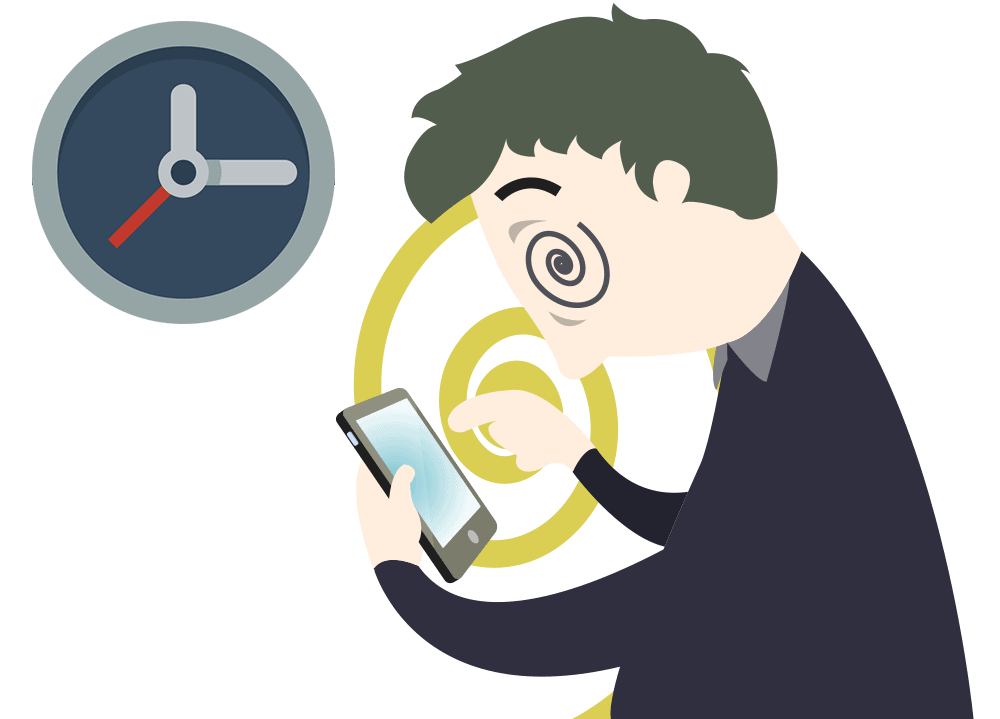
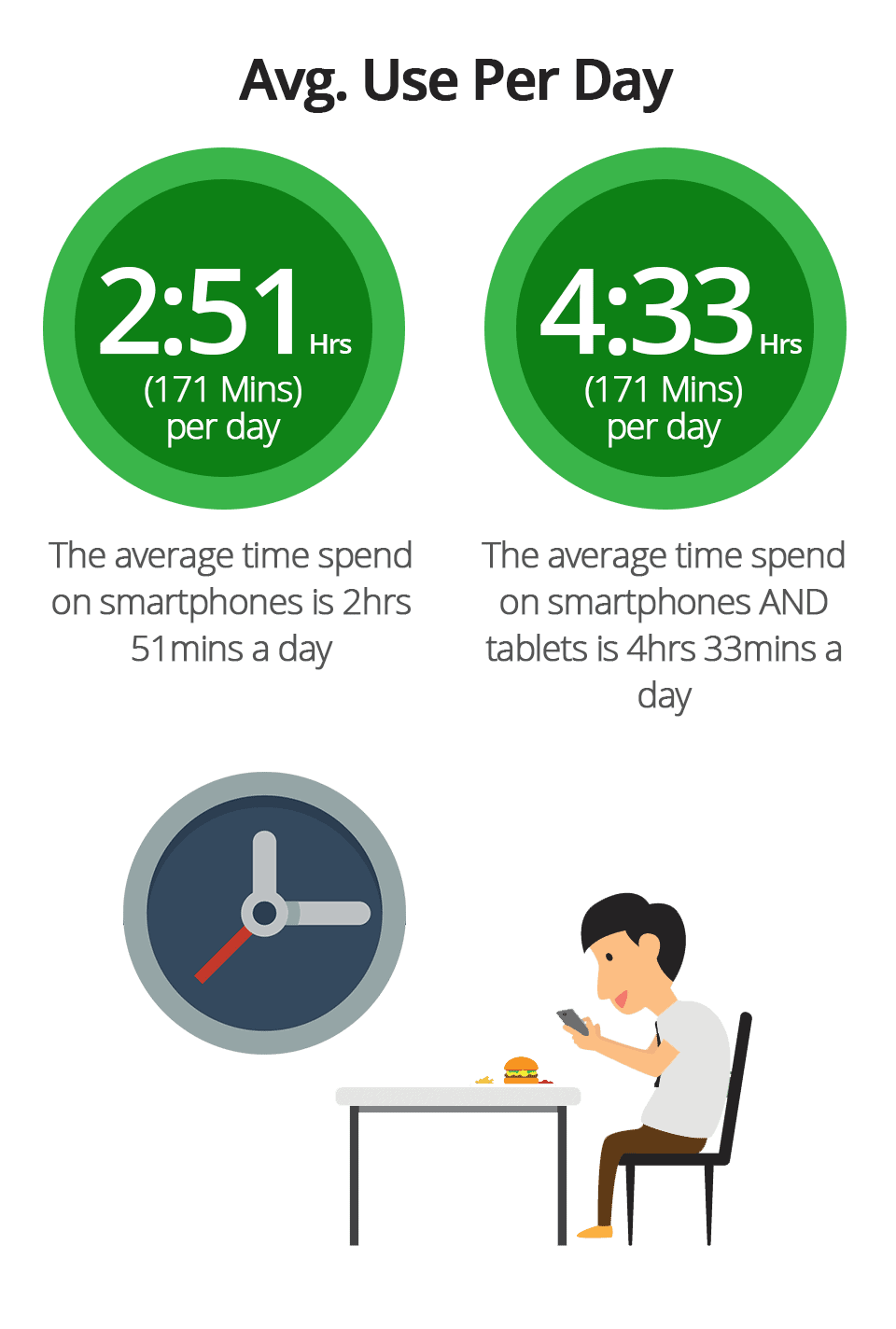
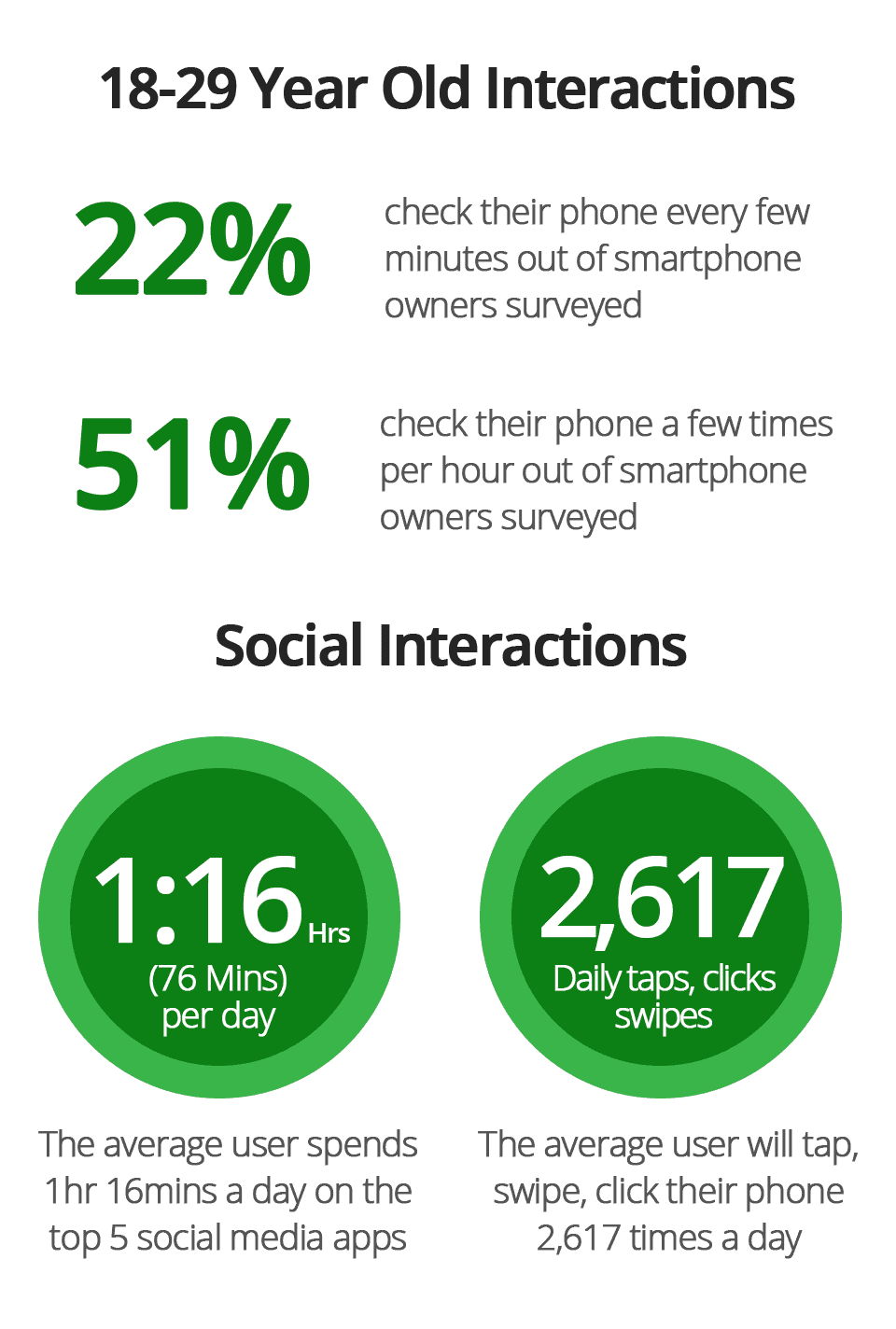
How Much Time do we Spend on Our Phones
- The average time spent on smartphones is 171 minutes a day (2hrs 51mins)
- The average time spend on smartphones AND tablets is 261 minutes a day (4hrs 33mins)
- The average user spends 76 minutes a day (1hr 16mins) on the top 5 social media apps
- The average user will tap, swipe, click their phone 2,617 times a day
- Out of 18-29-year-old smartphone owners surveyed, 22% check their phone every few minutes, 51% check a few times an hour
Cell Phone Usage Statistics
We can all agree that, in general, people are spending too much time on their phones, but how much time are we actually spending consuming content on our mobile devices? There have been multiple surveys carried out around the world which shows that every country has a different level of daily use, below are the countries in order by the average time from all sources.
Top 10 Countries with Smartphone Usage
- Brazil
- China
- United States
- Italy
- Spain
- South Korea
- Canada
- United Kingdom
- Germany
- France
Key cell phone usage statistic: The average time for people on their phones in the US is 4 hours a day (including tablets). As these devices become more integrated into our personal and digital lives, this increase in time is a depiction of both a culture and technology shift.
Key cell phone usage statistic: The average user in Brazil spends over 5 hours a day on their device, if you really think about it this is crazy… Every 1/5 days is spend on their phone.
Child Phone Addiction Data
Does You Teenager Or Child Have Smartphone Addiction?
The lack of maturity in the child or teen weighs negatively on their ability to curb smartphone and app use – Resulting in a growing concern from parents about their child’s cell phone dependence and the physical and psychological impact it has on them.
In this section we explore:
- The impact of smartphone overuse on kids
- Teenage cell phone addiction
- Parental feedback on their child’s phone use
- Ways to reduce a child’s dependence on smartphones

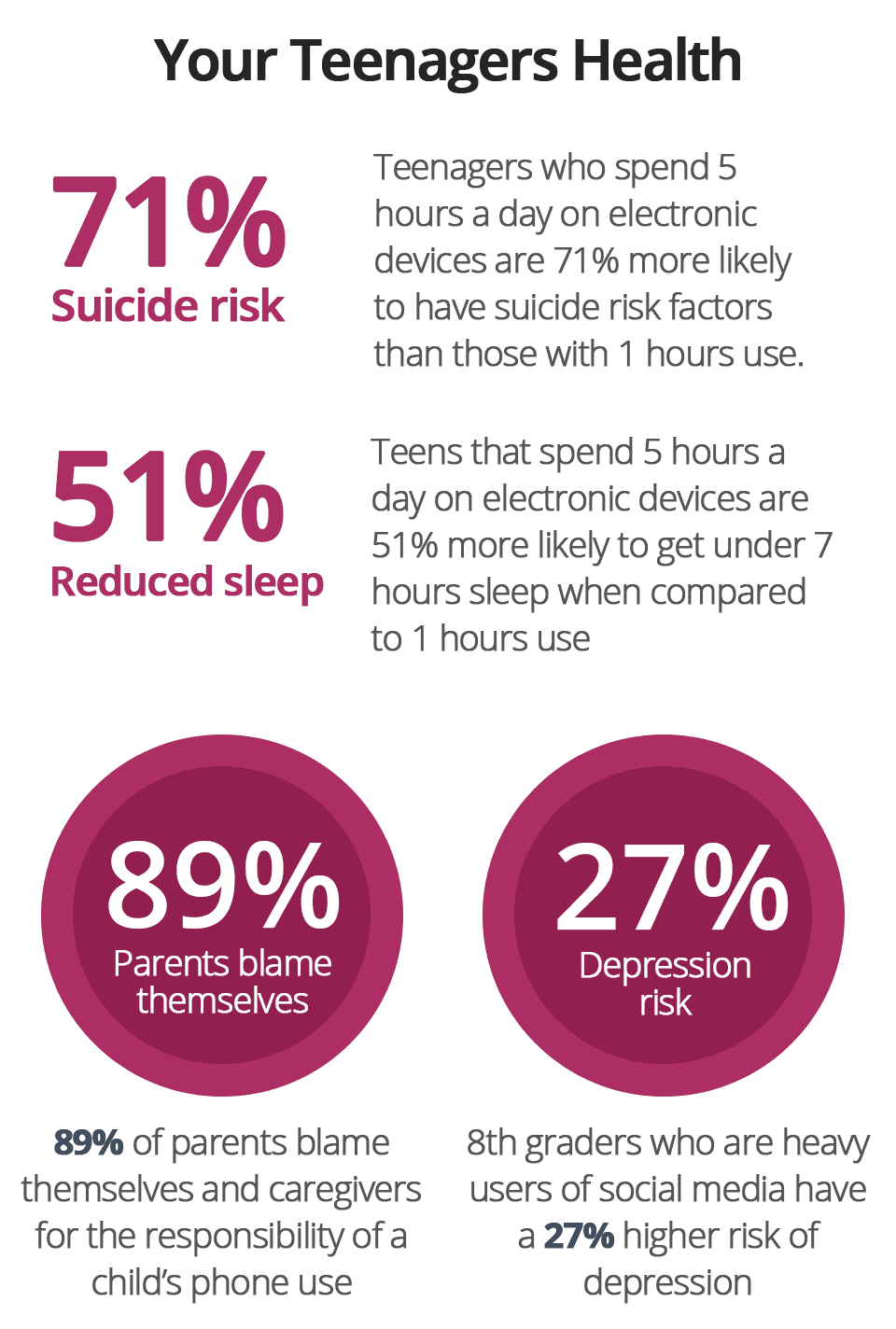
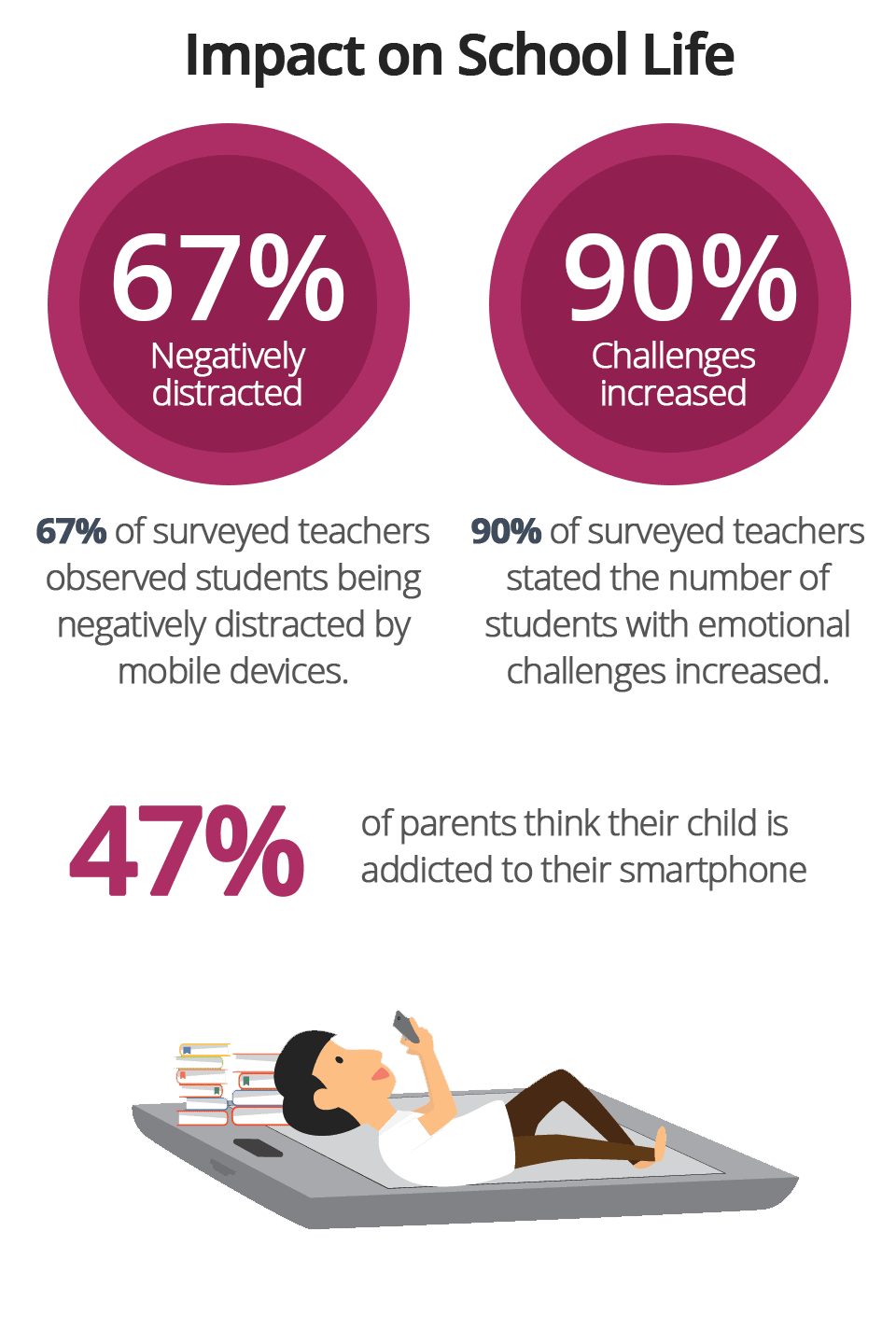
Is Your Child Spending Too Much Time on Their Phone?
- 67% of surveyed teachers observed students being negatively distracted by mobile devices.
- 90% of surveyed teachers stated the number of students with emotional challenges increased.
- Teenagers who spend 5 hours a day on electronic devices are 71% more likely to have suicide risk factors than those with 1 hours use.
- Teens that spend 5 hours a day on electronic devices are 51% more likely to get under 7 hours sleep when compared to 1 hours use. (Long-term issues linking to high blood pressure and weight gain)
- 8th graders who are heavy users of social media have a 27% higher risk of depression
- 89% of parents blame themselves and caregivers for the responsibility of a child’s phone use
- 5% blame children themselves, 3% blame the device and app manufacturers
- 47% of parents think their child is addicted to their smartphone
- 50% of parents are concerned for the impact on their mental health
Ways to Reduce a Child’s Dependence on Smartphones
When looking to resolve teen phone addiction, the obvious option of taking your child’s phone away often don’t work. As mentioned in the chapters above, this can just result in the withdrawal symptoms of the internet and technology addiction. You, your child or teenager, will lack the maturity to realize the bigger picture, so you’re going to have to try some other tactics to evoke healthier usage.
How to stop kids being addicted to their phone:
Use apps to monitor use: The new iOS Digital Health and Androids usage tracking can help you to know how much your child is actually using the device as well as the nature of the use, e.g. apps, emails, messaging.
Manage your own use: You need to be the role model in this situation, if you spend hours looking at your phone, check it during conversations and let it come between you and family interactions then you’re setting a poor example.
Create rules around the house: By restricting the use of smartphones in certain areas of the house or certain times you can create a much healthier environment. For example, no phones at the dinner table or after a certain time at night, perhaps even ban them from having phones in their rooms at night.
Nurture other interests: Another way to reduce how kids are addicted to phones is to involve them in more social and physical activities (sports/hobbies) to help them develop real interactions and reduce stress through exercise.
Communicate: Spend time as a family without mobile devices, communicate and be close enough with your child to know if there are underlying problems that the overuse of smartphones is masking issues such as depression or stress relating to issues at home or school.
Stopping Phone Addiction
How To Break Up With Your Phone
There is a vast amount of small actions that you can take to reduce cell phone usage and curb your addiction. Most of which require being self-aware and actively changing habits that encourage phone use, our consumer feedback survey covers some simple steps to take.
In this section we explore:
- Smartphone addiction self-help tips
- How to modify your smartphone use
- How to break phone addiction

Smartphone Addiction Self-Help Tips
We recommend using the new iOS Digital Health and Androids usage reports to keep track of the time you’re spending on your phone. The best place to start is by understanding exactly how much time you’re using your device and what apps you’re using the most.
- Realize what the triggers are that make you addicted to your phone, find better uses for your time to reduce your daily stress and boredom.
- Make conscious efforts to interact with people in person rather than via your phone. Our bodies and minds are built to thrive and develop off of human interactions, isolation with technology will impact you negatively.
- Recognize when you’re using a smartphone as a wall. If you find it easier to communicate with others through messaging or social media or vent online, work on those skills rather than hiding behind technology.
How to Modify Your Smartphone Use
If you’re wondering how to break cell phone addiction, the best way is to think of it as physical addiction such as smoking, drinking or eating. It’s about recognizing habits and working on slowly reducing the time to manageable amounts.
- Limit times that you can use your device. Try checking your phone after meals, don’t take it with you to the bathroom and ban it from the bedroom.
- Turn off your phone or put it out of sight. Placing your phone in a drawer at work or leaving it in another room to charge can help reduce the anxiety of wanting to check it.
- Don’t let your phone interrupt your sleeping patterns. Looking at your tablet, phone or laptop before bed can impact the quality of sleep you get. Try turning it off.
- Focus your boredom on other activities. If you’re just sat there with the TV on in the background and scrolling aimlessly on your phone, try putting that time into the gym, a hobby or going to meet friends and catch up.
- Limit times you play games or look on social media. Perhaps only use a game at certain times of the day, or try deleting social media apps you’re spending too much time on (social media being one of the primary causes of phone addiction)
- Checking your phone every 5 minutes? Wait for an hour or more, you’re probably getting an underlying feeling you’re missing out but you can wait for your fix.
Digital Health Impact
Cell Phone Manufacturers Software Solutions To Phone Addiction
Both Apple and Google (Android) have implemented plans to help combat phone addiction via software on their devices. Even though recent poll data suggests that almost 90% of people take responsibility for their own addictions, the software companies still have taken action.
In this section we explore:
- The impact of Apple’s iOS update
- The global market split
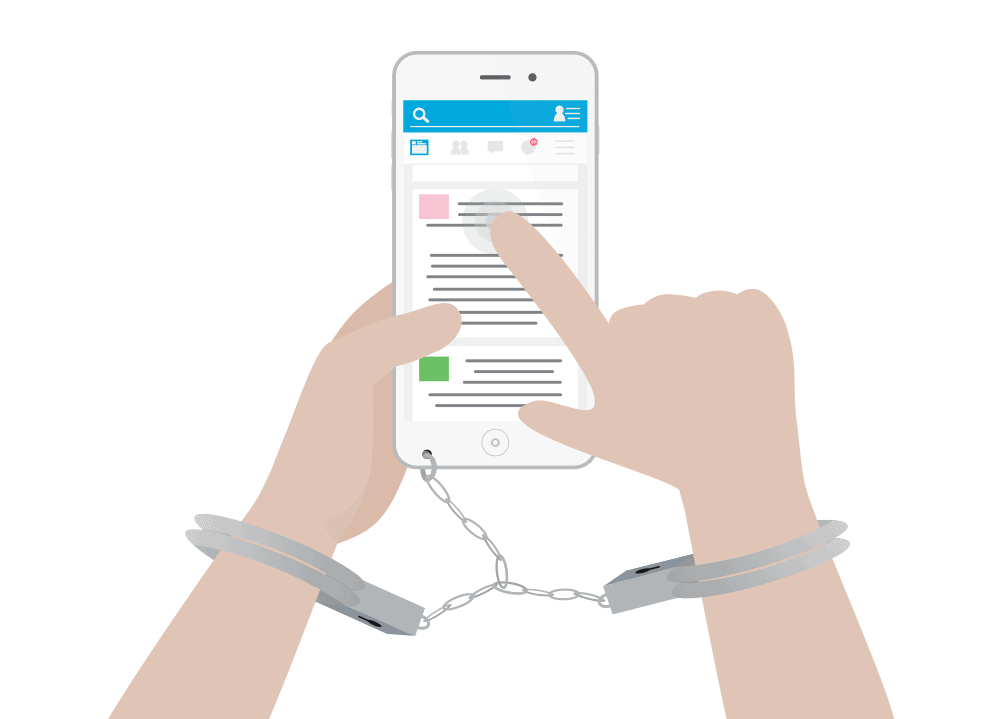
Apple's iOS Digital Health Update
These statistics show Apple’s market share over that past few years split down by quarter, suggesting this highly anticipated update will be available on around 15% of all smartphones shipped.
The keynote at WWDC will no doubt raise awareness of the tools people can now use to realize how they interact with devices and apps on a day to day basis.
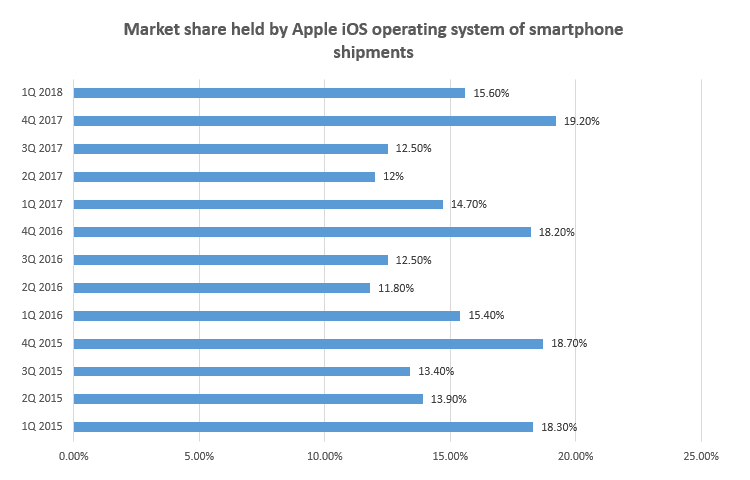
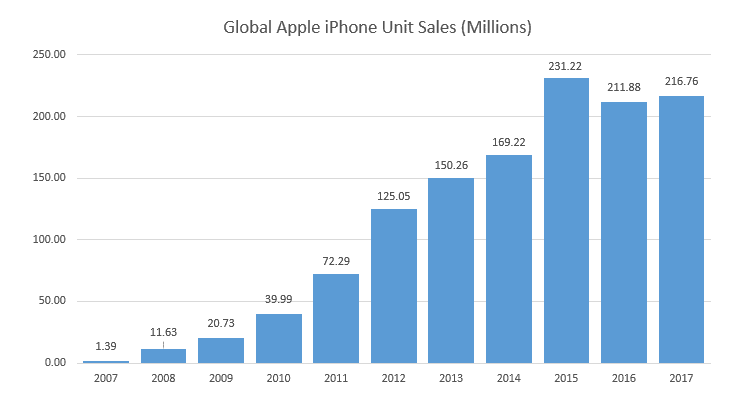
- In 2017 over 1,537M smartphones were sold, 14.0% of which run on iOS
- 85% run on Android, in May 2018 at the Google I/O they introduced a series of management tools that help manage similar functions to track usage
United States Vs Phone Addiction
Chronological And Regional U.S. Cell Phone Dependence
America has over 265.9 Million smartphone users and is ranked the 3rd highest country globally for daily screen time. We investigated search data from US citizens in correlation to their phone dependence, exhibiting the increase in the desire to find a solution over time and where has the highest impact geographically.
In this section we explore:
- US phone addiction 2004-2019
- US states with the highest concern
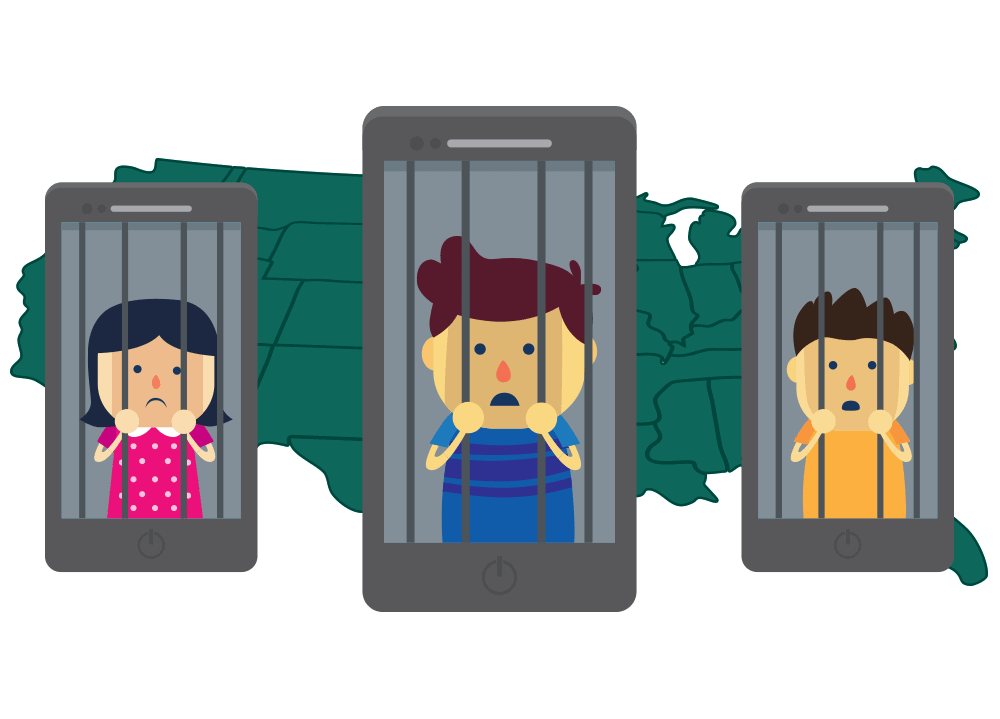
American’s Desperately Looking For a Phone Dependence Solution
It’s no shock that phone addiction has gripped America, in fact, the US is the ranked the 3rd highest country for smartphone usage behind Brazil and China. We began pairing up phrases like ‘help’ and ‘support’ with cell phone addiction-related terms to measure chronological search volume increases across the United States.
Below is the collective US search intent data trends from January 2004 to June 2019:
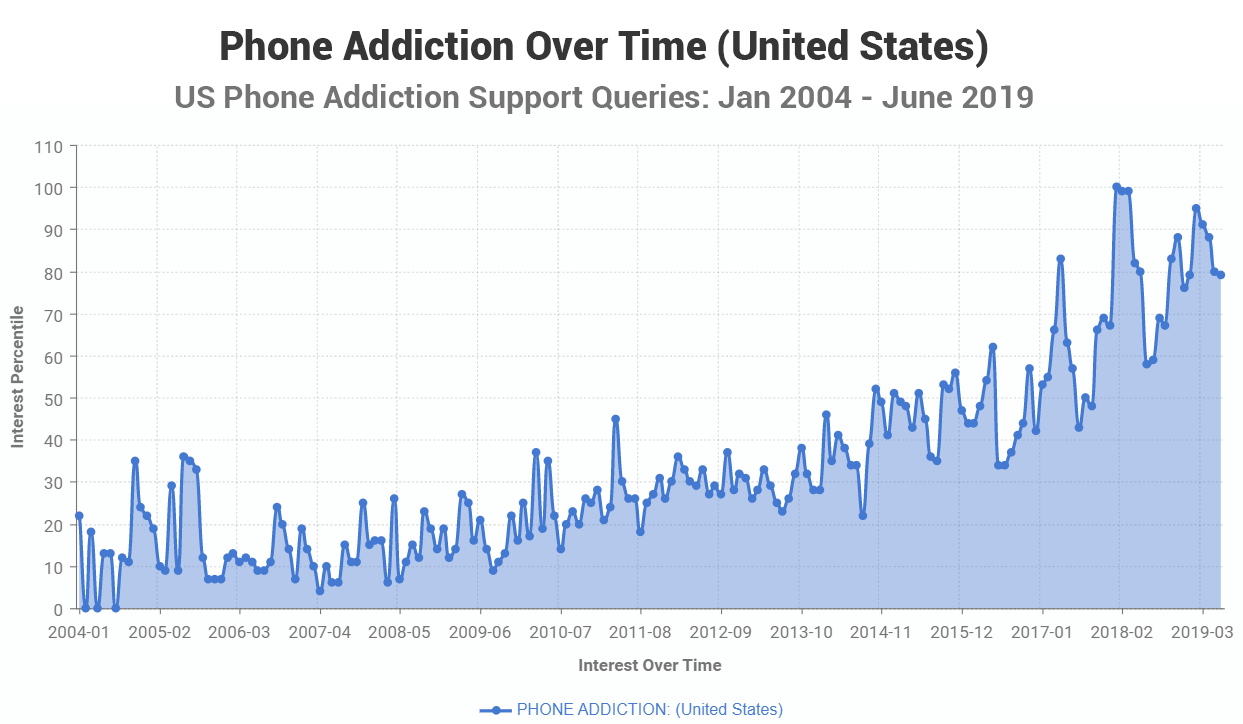
*The numbers represent search interest relative to the highest point on the chart for the United States. A value of 100 would be considered the peak popularity, 50 would be half of the collective terms volume.
The above data shows a vast increase in the average American’s desire to fix their phone overuse.
- From 2014 to present we can see an accelerated upwards trend, this reflects a greater adoption of smartphones versus regular phones coupled with technological advances increasing the addictiveness of the devices.
- In 2018 we see the highest percentile of the chart, this was the year where leading operating systems iOS and Android released software updates for users to visualize and monitor their use (or overuse).
Which US State Has The Most Phone Addicts In 2019?
Similar to the data above, we matched phrases like ‘help’ and ‘support’ with cell phone addiction-related terms, comparing states with the highest relative proportion of their population searching for support in terms of managing their phone use.
Below is the collective US search data from January 2019 to June 2019
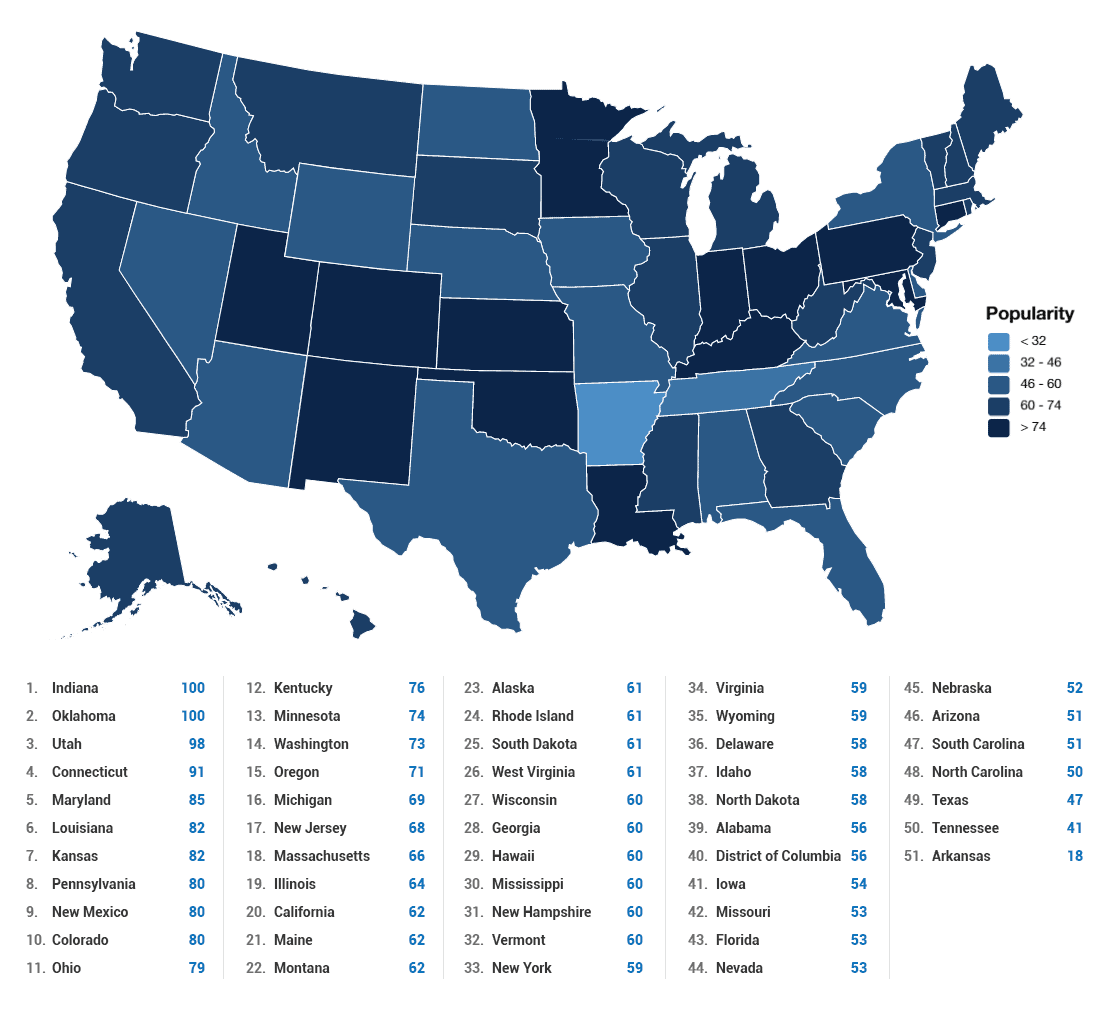
The numbers represent search interest relative to the highest point on the chart for the United States. A value of 100 would be considered the peak popularity, 50 would be half of the collective terms volume.
The above data shows a vast increase in the average American’s desire to fix their phone overuse.
- States with the highest local search intent are Indiana, Oklahoma, Utah, Connecticut, Maryland
- States with the lowest local search intent are Arkansas, Tennessee, Texas, North & South Carolina
Report Sources
https://www.hotjar.com/ – our survey 4,328 respondents (USA/UK)
https://trends.google.com/trends/?geo=US
https://infographic.statista.com/normal/chartoftheday_12403_smartphone_addiction_n.jpg
https://www.statista.com/chart/9539/smartphone-addiction-tightens-its-global-grip/
https://www.statista.com/chart/3666/frequency-of-smartphone-usage/
https://www.statista.com/chart/13052/smartphone-addiction-among-children/
https://www.statista.com/statistics/236031/market-share-of-ios-in-global-smartphone-os-shipments/
https://www.comscore.com/Insights/Blog/Mobile-Matures-as-the-Cross-Platform-Era-Emerges
https://www.insiderintelligence.com/coverage/
How Much Is Your Phone Worth?
To get an idea of the values you can get when selling your old phone in the US, check out our latest phone trade-in pricing below:

